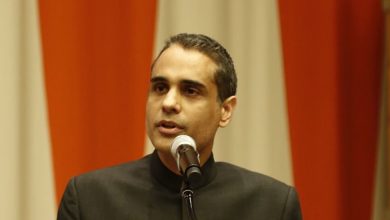An Innovative Vocalist Lost Her Speech, but She’s Still Performing

Last April, the Vienna-based avant-garde jazz vocalist Linda Sharrock gave her first New York performance in over 40 years: a sold-out concert at BAM’s Howard Gilman Opera House, as part of a series curated by Solange. Appearing between the poet Claudia Rankine and the saxophonist Archie Shepp, Sharrock guided eight musicians through a fully improvised set while she howled powerfully over the cacophonous squall of free jazz in a declamatory style that evoked the evening’s program title, “The Cry of My People.”
It wasn’t until after she’d received multiple standing ovations that most of the audience realized the 76-year-old singer wasn’t able to speak: Sharrock became aphasic after a 2009 stroke that paralyzed her right side; she now uses a wheelchair. A few weeks later at the Cambridge, Mass., home of the pianist Eric Zinman, who plays in her group the Linda Sharrock Network, Sharrock was unable to verbalize much more than “yeah,” “no,” “OK” and “I don’t know.”
Despite her limited dialogical abilities, Sharrock was cheerful, charming and quick to laughter. Much of the talking was done by her caregiver — Mario Rechtern, an 81-year-old Austrian free jazz saxophonist who has, by his account, overseen her personal affairs and daily activities for the last 20 years. He not only plays in her band, he helps her dress, feeds her if necessary and carries her down the stairs.
“This work with Linda is consuming,” Rechtern said, tugging at his woolly gray beard, “and at the same time, I cannot give in to the consuming, because when I give in, she’s lost. So it’s challenging.”
Sharrock’s return to the stage — a manifestation of her stubborn refusal to be silenced — is one of the most stirring comeback stories in recent memory. Over a career stretching six decades, Sharrock has been a resolutely singular figure; almost no peers share her uniquely unorthodox vocal delivery. Too “out” for jazz’s in-crowd, she was relegated to relative obscurity. Yet her commitment to challenging her audience has ultimately made her a role model for experimental vocalists and Black female performers, providing a beacon of tantalizing possibilities.
The poet and vocalist Camae Ayewa, who performs as Moor Mother, recalled hearing Sharrock’s music for the first time and “losing my mind,” she said in an interview. “I wrote a little poem about this because it was such urgency on my part to be like, ‘What is going on here? This is where I want to go! This is what I want to sound like!’ I hadn’t heard anyone before that had inspired me this way besides Betty Carter. I just started to be obsessed about it.”
Sharrock’s vocal exclamations have become deeper and more guttural moans than the high-pitched shrieks of her early work with her then-husband, the musician Sonny Sharrock. In the late 1960s, Sonny revolutionized jazz guitar through volume, distortion and feedback while playing with Pharoah Sanders, Don Cherry, Wayne Shorter and Miles Davis. Linda’s approach was no less radical: On three albums of collaborations with Sonny, beginning with their remarkable 1969 debut “Black Woman,” her wordless exhortations included psychedelic sighs, orgasmic yodels and blood-chilling screams, all delivered with an intensity that made “Plastic Ono Band”-era Yoko Ono sound like Anne Murray in comparison.
“I’ve never listened to any kind of a female jazz singer for any kind of inspiration or anything like that,” Sharrock said in a 1973 WKCR radio interview. “I was influenced by horn players,” she explained, citing incendiary saxophonists like Sanders and Albert Ayler.
“The thing that killed me about her singing was that she was, if not the first, one of the few jazz singers who improvise,” Sonny said in the same WKCR conversation. “That’s one of the reasons she doesn’t use words: because it hinders your improvisation.”
Sharrock was born Linda Chambers in Philadelphia, and lived with her grandmother and her younger brother, Pablo, in the working class Germantown neighborhood, according to Jacquelyn Bullock, a longtime friend and former neighbor. In an interview, she said that despite Sharrock’s confrontational vocal approach, offstage “she was quiet and demure,” with an interest in fashion and a distinctive sense of style. “She’s a gracious woman. Like most women, she likes nice things, and she has a great sense of humor.”
Sharrock moved to New York after graduating from high school in 1965 with the intention to study painting, but soon became immersed in the Lower East Side’s jazz scene, where her inaugural professional gig was singing with Sanders. When she first began performing, she shaved off her eyebrows and kept her hair close-cropped, she told The New York Times Magazine in 1975. “It was the strangest look I could conceive of,” she said. “My life had taken such a drastic change, I wanted to present it physically.”
She met Sonny through Sanders, and they married in 1967. Earnings for most free jazz musicians were lean, but that year, Sonny got the opportunity to work with the commercially successful jazz-funk flutist Herbie Mann, and spent most of the next seven years playing in his group. Linda went on tour with them and eventually joined the band, usually performing two of the couple’s compositions each night, “Black Woman” and “Portrait of Linda in Three Colors, All Black.”
The Sharrocks lived in an apartment at 77 East 3rd Street in the East Village; the pianist Dave Burrell was a neighbor and hosted rehearsals for the 1969 “Black Woman” album in his tiny living room. Burrell recalled in an interview that hearing Sharrock sing for the first time, “I felt a bolt of excitement,” he said. “I thought of her as a vocalist who could throw herself into the ‘Black is beautiful’ moment and movement, and that made her one of the boys, so having her around was cool.”
Another “Black Woman” musician, the trumpeter Ted Daniel, was a childhood friend of Sonny’s from Ossining, N.Y. “She was one of a kind,” Daniel said in an interview. “I haven’t heard anybody sing with the raw passion and just that kind of freedom that she approached in her singing with Sonny in that band.”
Released on the Vortex subsidiary of Atlantic Records, the trailblazing “Black Woman” failed to find a larger audience. A few years later, the couple put together the Savages, a working band that could play out regularly. The group included steel drums and Latin percussion and gigged at downtown venues like the Tin Palace and lofts like Studio Rivbea, said Abe Speller, the band’s drummer. The Savages recorded a soundtrack to Sedat Pakay’s 1973 short documentary “James Baldwin: From Another Place” and performed a live set in 1974 on WKCR, which are the only surviving souvenirs of their existence. Speller recalled the band holing up to rehearse before entering a studio in December 1977 to record a four-song demo tape, but the group failed to score a label deal and eventually fizzled out.
After Linda and Sonny divorced, she moved to Turkey and then Vienna, where she met her second husband, the Austrian saxophonist Wolfgang Puschnig, a few years later. (Sonny died in 1994 at 53.) Initially they were just musical collaborators, Puschnig said in a video call from his home in southern Austria, but a relationship blossomed and they were married in 1987 while in Mozambique for a gig.
Under their own names and in groups like the Pat Brothers, AM4 and Red Sun, Puschnig and Sharrock recorded more than 20 albums together on European and South Korean labels from 1986 to 2007, but her vocal approach had changed markedly. Puschnig said that she moved away from singing in her free style after consulting a former Ziegfeld girl turned palm reader, who told her, “I see you’re a singer, but you don’t use words, but you should because you have a talent to use words.”
“So that’s how she started to do lyrics,” he said.
The jazz fusion bassist Jamaaladeen Tacuma performed with them for years, and produced “On Holiday,” Sharrock’s 1990 album of Billie Holiday covers, complete with new jack swing beats and a rapper. “She was pushing the ball,” Tacuma said in an interview, “thinking outside of the box, in terms of music, creativity, and improvisation, and trying to bring something about musically with her voice that had not been done before.”
Puschnig said Sharrock’s health started to deteriorate in the mid-1990s, and though their romantic relationship ended around 1996, they continued working together as late as 2007. Around 2004, Rechtern — who had first met Sharrock in 1979 — began caring for her, and was granted power of attorney in 2007. “She was really falling into the nothingness,” Rechtern said. “If I wouldn’t have taken her she would be in a home.”
During surgery for an intestinal blockage in 2009, Sharrock suffered her stroke, and spent the following two years in and out of the hospital. In 2012 she was visited in Austria by the jazz bassist Henry Grimes. “She was sitting on the couch while he played,” Rechtern recalled, “and I heard her very softly singing into the music.”
Intrigued, Rechtern began gradually coaxing Sharrock to perform again. “She started to develop first this growl sound, this cry, because she couldn’t articulate,” he said. “Out of the blues and this typical sound, she found this explosion.”
Beginning with “No Is No” in 2014, Sharrock has released five recordings in Europe since her stroke. Her recent music is more in the spirit of the free jazz she made with Sonny than her somewhat more conventional work with Puschnig, though her vocal range is understandably not the same.
Sharrock responded affirmatively when asked if she had needed to sing and perform again, and when asked if she felt better while onstage, she cracked up laughing.
“This music is healing for her,” Rechtern replied. “There’s no doubt.”
Sharrock’s work and perseverance has inspired a new generation of artists. “So much of it doesn’t have lyrics,” Taja Cheek, who performs as L’Rain, said in an interview, “and isn’t easy to understand in a certain kind of way, but I understood it, and I felt it so viscerally when I first heard her that it got very emotional for me.”
On a recent re-listen of “Black Woman,” Cheek said, “it sort of hit me like a ton of bricks that ‘Oh, Linda Sharrock is the lineage I might be a part of.’ I am able to do what I’m doing, and it can be met with a little bit of understanding, because Linda has already done something like this.”
Sharrock’s resiliency has resonated with her old colleagues, as well. “It is very telling about the heart of a performing artist wanting to be able to do that until it’s completely impossible,” Burrell said, “another further dimension of the determination that she still has, no matter what the circumstances. I’m very proud of her.”




